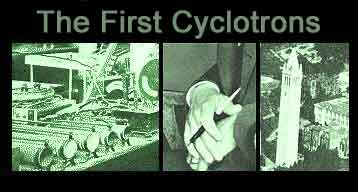

|
|
|
At Rutherford's Cavendish Laboratory in Cambridge, England, John Cockcroft and E.T.S. Walton produced such particles artificially by accelerating protons, with a high-voltage transformer and then with a voltage multiplier. Robert Van de Graaff, an NRC postdoc at Princeton and then MIT, built an electrostatic high-voltage generator. Merle Tuve, Lawrence's old friend, now working at the Carnegie Institution of Washington, experimented with a Tesla induction coil, then with a Van de Graaff generator and reached a million volts. |
||||
 Early cyclotroneers include J.J. Livingood, F. Exner, M.S. Livingston, D. Sloan, E.O. Lawrence, M. White, W. Coates, L. Laslett, and T. Lucci in 1933. |
|
|
|
|
||||||
—Telegram
to Lawrence, Click here to learn more on early particle accelerators and first cyclotrons |